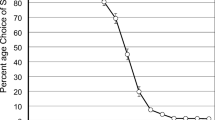Abstract
Procrastination is the tendency to delay initiating or completing tasks. Rosenbaum et al. (Psychological Science, May 8, 2014) recently documented the opposite of procrastination: pre-crastination, the tendency to begin or to finish tasks as soon as possible. We devised a simple two-alternative forced-choice task, in which pigeons could choose to switch response location either sooner or later in a sequence of actions eventuating in food reward. Even though there was no economic advantage for doing so, pigeons chose to switch response location sooner rather than later in the sequence, showing pre-crastination to be quite general. Pre-crastination thus joins other anticipatory learning phenomena in challenging rational or optimal accounts of behavioral adaptation.


Similar content being viewed by others
References
Bhatt, R. S., & Wasserman, E. A. (1987). Choice behavior of pigeons on progressive and multiple schedules: A test of optimal foraging theory. Journal of Experimental Psychology: Animal Behavior Processes, 13, 40–51.
Brainard, D. H. (1997). The psychophysics toolbox. Spatial Vision, 10, 433–436.
Cook, R. G., Brown, M. F., & Riley, D. A. (1985). Flexible memory processing by rats: Use of prospective and retrospective information in the radial maze. Journal of Experimental Psychology: Animal Behavior Processes, 11, 453–469.
Cook, R. G., & Rosen, H. A. (2010). Temporal control of internal states in pigeons. Psychonomic Bulletin & Review, 17, 915–922.
Dennett, D. C. (1996). Kinds of minds: Towards an understanding of consciousness. New York: Basic Books.
Gibson, B. M., Wasserman, E. A., Frei, L., & Miller, K. (2004). Recent advances in operant conditioning technology: A versatile and affordable computerized touch screen system. Behavior Research Methods, Instruments and Computers, 36, 355–362.
Hearst, E., & Jenkins, H. M. (1974). Sign-tracking: The stimulus-reinforcer relation and directed action. Austin, TX: Psychonomic Society.
Hendry, D. P. (1969). Conditioned reinforcement. Homewood, IL: Dorsey Press.
Honig, W. K., & Wasserman, E. A. (1981). Performance of pigeons on delayed simple and conditional discriminations under equivalent training procedures. Learning and Motivation, 12, 149–170.
Houston, A. I., & McNamara, J. M. (1999). Models of adaptive behaviour. Cambridge, UK: Cambridge University Press.
Hurley, S., & Nudds, M. (2006). Rational animals? Oxford: Oxford University Press.
Locurto, C. W., Terrace, H. S., & Gibbon, J. (1981). Autoshaping and conditioning theory. New York: Academic Press.
Mazur, J. E. (1996). Procrastination by pigeons: Preference for larger, more delayed work requirements. Journal of Experimental Analysis of Behavior, 65, 159–171.
McDaniel, M. A., & Einstein, G. O. (2007). Prospective memory: An overview and synthesis of an emerging field. Thousand Oaks, CA: Sage.
Pelli, D. G. (1997). The VideoToolbox software for visual psychophysics: Transforming numbers into movies. Spatial Vision, 10, 437–442.
Pithers, R. T. (1985). The roles of event contingencies and reinforcement in human autoshaping and omission responding. Learning and Motivation, 16, 210–237.
Rosenbaum, D. A., Gong, L., & Potts, C. A. (2014). Pre-crastination: Hastening subgoal completion at the expense of extra physical effort. Psychological Science, 8, 2014.
Simon, H. A. (1972). Theories of bounded rationality. In C. B. McGuire & R. Radner (Eds.), Decision and organization (pp. 161–176). Amsterdam: North-Holland.
Wasserman, E. A. (1981). Response evocation in autoshaping. In C. M. Locurto, H. S. Terrace, & J. Gibbon (Eds.), Autoshaping and conditioning theory (pp. 21–54). New York: Academic Press.
Wasserman, E. A., Carr, D. L., & Deich, J. D. (1978). Association of conditioned stimuli during serial conditioning by pigeons. Animal Learning & Behavior, 6, 52–56.
Wike, E. L. (1962). Secondary reinforcement: Selected experiments. New York: Harper & Row.
Williams, D. R., & Williams, H. (1969). Auto-maintenance in the pigeon: Sustained pecking despite contingent non-reinforcement. Journal of the Experimental Analysis of Behavior, 12, 511–520.
Zentall, T. R. (2010). Coding of stimuli by animals: Retrospection, prospection, episodic memory and future planning. Learning and Motivation, 41, 225–240.
Acknowledgments
We thank Leyre Castro and Mike O’Hara for their helpful comments and suggestions.
Author information
Authors and Affiliations
Corresponding author
Rights and permissions
About this article
Cite this article
Wasserman, E.A., Brzykcy, S.J. Pre-crastination in the pigeon. Psychon Bull Rev 22, 1130–1134 (2015). https://doi.org/10.3758/s13423-014-0758-3
Published:
Issue Date:
DOI: https://doi.org/10.3758/s13423-014-0758-3




